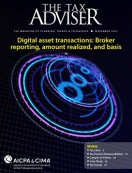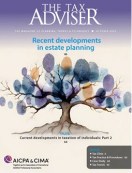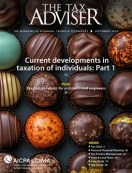- tax clinic
- credits against tax
Tax Court declines to limit discovery for sampled research credit claims
Related
Notice 2025-27 provides interim guidance on corporate AMT
Two Tax Court rulings expose overvalued conservation easements
Late election relief in recent IRS letter rulings
Editor: Greg A. Fairbanks, J.D., LL.M.
Two recent Tax Court cases, Phoenix Design Group Inc., No. 4759-22 (T.C. 8/29/23) (order denying petitioner’s motion for a protective order), and Kapur, T.C. Memo. 2024-28, involved disputes over denied credits for increasing research activities (research credits). In each case, the taxpayers attempted to limit discovery to a small number of selected example projects, but the court rejected the motion. This item discusses the benefits of employing statistical sampling to claim research credits and considerations from these two cases. The discussion focuses specifically on the importance of proper documentation when claiming research credits and the IRS’s right to request evidence beyond projects selected by a taxpayer using judgment sampling.
Use of statistical sampling for estimating taxable values
Rev. Proc. 2011-42 provides safe-harbor guidelines for taxpayers to use when estimating values for federal income tax purposes. It states that sampling and estimation (performed with proper statistical methods) is appropriate when (1) no better probative information can be gathered and (2) the effort of making tax determinations on all the items is burdensome. The IRS has a long history of accepting statistically sound estimates for the research credit (see Song et al., “The Research Credit: Using Statistical Sampling,” 53-2 The Tax Adviser 11 (February 2022)).
Typically, with estimates for the research credit, a listing of potentially qualifying projects is prepared; this is the “population” or “sampling frame.” The projects generally correspond to “business components,” defined as a product, process, computer software, technique, formula, or invention that the taxpayer either holds for sale, lease, or license or uses in its trade or business (Sec. 41(d)(2)(B)). A random sample of the listed projects is drawn, tax determinations of the qualified research expenditures (QREs) are made for each sampled project, and the results of the sample selections are used to extrapolate an estimate of the QRE amount over the entire project population.
In fact, Rev. Proc. 2011-42 suggests four simple methods of extrapolation. The safe-harbor guidelines in Rev. Proc. 2011-42 require the estimate’s accuracy to be calculated via statistically valid formulas, and the taxpayer must use an unfavorable value for the tax return if the estimate has insufficient accuracy. Therefore, the ability to determine accuracy using statistical principles is necessary to follow the safe-harbor guidelines.
Two appendices in the revenue procedure (“Appendix A: Sampling Plan Standards” and “Appendix B: Sampling Documentation Standards”) outline documentation standards for taxpayers to follow when using statistical sampling and estimation. In addition to the statistical methods employed, the appendices clearly require supporting documentation of the tax determinations made for each sampled item. In the case of the research credit, tax determinations include a four-part test analysis to determine (1) whether a project or its corresponding business component qualifies for the credit and (2) a calculation of each sampled project’s QREs. The effort per project can be quite onerous at times. While revenue procedures have no tax authority, it is reasonable to expect the IRS to follow them. Typically, when the IRS audits a taxpayer’s estimate, a company can expect that the Service will request the documentation listed in the two appendices.
As discussed in further detail below, the two Tax Court cases departed from the more commonly followed safe-harbor guidelines when (1) the taxpayers requested that the IRS limit disclosure to only a few example projects from their sample selections and (2) the IRS requested additional production information regarding all items in the population. It is also confusing that, in both cases, the court refers to both the taxpayer-requested subset of example projects and the originally drawn full random sample as “samples.” To provide clarity throughout this item, the subset of the randomly drawn sample is referred to as “example projects,” and the original full sample will be referred to as “random samples.”
Phoenix Design Group Inc.
As noted in the order denying petitioner’s motion for a protective order (T.C. 8/29/23), Phoenix Design Group was engaged in the business of engineering and consulting and focused primarily on designing mechanical, electrical, plumbing, and fire protection systems. The taxpayer hired a professional-services firm to compute research credits, which included evaluating 409 projects that took place during 2013—2016. The professional-services firm eliminated de minimis projects, which reduced the list to 238 projects that potentially qualified for the research credit, and drew a sample of 24 of the 238 projects. The professional-services firm determined that 20 of the 24 sample projects qualified for the research credit and used the results of the sample to extrapolate QREs.
The IRS audited the taxpayer for 2015—2019 and issued a notice of deficiency, which included $553,547 in combined deficiencies and penalties under Sec. 6662(a) resulting from the Service’s disallowance of the company’s research credits. The IRS’s initial basis for fully disallowing the research credits is not clear from the court documents. The taxpayer filed a petition with the Tax Court to redetermine the deficiencies.
During the informal discovery process in preparation for trial, the taxpayer provided the IRS with documentation for the 20 qualified projects; however, the IRS subsequently requested “production related to all 238 research projects underlying the research credits.” Such a request is unusual because when a taxpayer uses sampling to estimate a value for their tax return, if it is a valid random sample, the IRS reviews the taxpayer’s random sample selections without going beyond the sampled cases. In response, the taxpayer filed a motion asking the Tax Court to limit discovery and trial to a subset of three to six example projects from the 20 projects that were determined to be qualified for the research credit.
The Tax Court denied the motion and stated that it would be improper to limit the scope of discovery in accordance with the taxpayer’s motion, noting that (1) the taxpayer bears the burden of demonstrating its entitlement to the credits; (2) the taxpayer had not “shown that the 3 to 6 selected projects were representative of the 238 projects underlying the research credits and would produce statistically valid results”; (3) the narrow scope requested by the taxpayer, with four tax years at issue, “could result in a nonreflective decrease in its tax liability and prejudice [the IRS]”; and (4) the IRS’s request for details was “reasonably calculated to produce relevant information” regarding the taxpayer’s eligibility for the credits. The court also noted that, without the agreement of both parties, it has “previously held that limiting the scope to a sample of research projects is improper because doing so would relieve a taxpayer of [the] burden of proving entitlement to the research credit” (citing Betz, T.C. Memo. 2023-84, at 77 n.30, and Bayer Corp., 850 F. Supp. 2d 522, 538, 545—46 (W.D. Pa. 2012)).
Although the motion was denied, the Tax Court acknowledged that taxpayers and the IRS may mutually agree to sampling, along with specifications of how to conduct the sampling process and extrapolation calculations based on the results from the sampled items. Furthermore, the court advised the IRS that its “continued cooperation and willingness to better streamline this case for trial is expected since it will preserve both judicial resources and resources of the parties.”
Kapur
In Kapur, Kapur & Associates Inc. (KAI), an S corporation, was a civil and environmental engineering firm that designed transportation and remediation systems. To determine the available research credits, KAI engaged a professional-services firm that computed the QREs from a population of 2,000—3,000 projects. Nonqualifying projects were removed from consideration, and then eligibility for the research credit was determined on a sample that was extrapolated to the remaining projects. The spouse taxpayers claimed a total of $238,958 in research credits flowing through to them from KAI for the 2014, 2016, 2017, and 2018 tax years. The IRS challenged some of the claims, issuing a deficiency of $186,648 and a Sec. 6662(a) penalty of $7,187.
The taxpayers had provided the IRS with supporting documentation for only two projects, which they represented comprised over 72% of the claimed QREs. Again, the IRS requested information regarding the production for the entire sampling frame and requested to interview 16 employees. Similarly to the plaintiffs in the Phoenix Design case, the taxpayers filed a motion to narrow discovery to interviewing two to four employees regarding two to four specific projects, including KAI’s largest ones, arguing that discovery related to 2,000—3,000 projects was not proportional to the amount in controversy.
The Tax Court stated that “it is common for parties to agree to sampling in lieu of extensive discovery and litigation with respect to each project.” The court provided example scenarios and related citations about how the court has addressed this issue for taxpayers:
- The parties agree at the outset to try a sample that is binding on all projects (Suder, T.C. Memo. 2014-201, at 15);
- The parties agree to try a sample with the expectation that the court’s conclusions will enable them to resolve their differences with respect to the remaining projects (Little Sandy Coal Co., T.C. Memo. 2021-15, at 20—21, aff’d, 62 F.4th 287 (7th Cir. 2023)); and
- The parties agree to sampling, but, since they are unable to agree on a method, the Tax Court has selected the sampling methodology (Tangel, T.C. Memo. 2021-1).
However, the Tax Court stated in Kapur that the situation that it faced was unusual, as the IRS rejected sampling completely. The court denied the taxpayers’ motion and noted that, while it has the authority to limit discovery, it agreed the IRS would not be able to choose a representative sample for discovery if it did not have preliminary information on all projects. Additionally, the court held that evaluating compliance with Sec. 41 involves consideration of the underlying business components and that the taxpayer has the burden of proof when claiming research credits.
To address the taxpayers’ argument regarding the request being disproportionate to the expense, the Tax Court added that the taxpayers could simply limit the credit claim to the projects they wanted in the sample, so that they would only be required to provide substantiation for the QREs for those projects. However, if they wanted more credits, they would need to be prepared to provide substantiation for the additional QREs. The court also added that the taxpayers could cooperate with the IRS and identify information regarding business components in the sampling frame to convince the Service to agree to a representative sample.
Statistical considerations
In these two cases, the IRS’s rejection of the taxpayers’ request to limit the review to just a few handpicked projects is soundly based in statistical theory. Statistically appropriate extrapolation of qualified amounts with a mathematically calculated measure of the estimate’s accuracy can only be determined from random samples (see Ashtiani and Rotz, “Managing Tax Audits Using Sampling Techniques,” 54-7 The Tax Adviser 38 (July 2023)).
While the use of random sampling to extrapolate QREs remains a valid method for determining research credits, Phoenix Design and Kapur both involve taxpayer attempts to limit the examination of original random samples to very few projects. In the Kapur case, this was just the two largest projects (i.e., a nonrandom subset), which contradicts the random assumptions required in the statistical theory that lays the foundation for extrapolating the estimate’s accuracy.
It should also be noted that random samples allow for mathematically quantifiable determinations of the accuracy of taxpayers’ estimates based on sound statistical formulas. Example projects do not allow for this unless they were randomly selected subsets out of the original full samples. However, the Tax Court does not draw that distinction in Phoenix Design or Kapur. Even if the example projects were randomly chosen, the very small sample sizes the taxpayers suggested would likely have poor accuracy (i.e., much worse than estimates calculated from the original full random selections).
Setting aside statistical measures of accuracy, using nonrandom cases for extrapolation (i.e., without a statistically based estimate of accuracy) requires the example cases to be representative of the population to yield unbiased conclusions. However, qualifying rates in the largest projects in a population are often quite different from the rates in smaller projects in many companies. The IRS cannot assess the handpicked examples’ representativeness without knowing something of the cases and the population.
While the IRS may choose to focus an examination on specific sample selections, it should not be expected to restrict an audit solely to the projects that the taxpayer claims, without proof, are representative of the entire population. Therefore, to support claimed research credits, it is essential to prepare proper documentation for all qualified projects within the sample and to be prepared to provide the IRS with that documentation in audit.
Regarding the IRS’s expanding its requests for information to include projects not in the sample, the Service requested “production” related to all projects in the population. It is unclear what specific information and level of detail the IRS was attempting to obtain in Phoenix Design and Kapur. While the Tax Court documents did not clarify what “production” documentation the IRS requested, the documents in Kapur do elaborate that this included the business component(s) associated with each project in the population. Of note, for the projects beyond the sample, the court records did not indicate if the IRS requested explanations of how the four-part test was met, QREs by project, or the kinds of supporting documentation, as cited in Rev. Proc. 2011-42’s two appendices, required for each sample. Still, depending on the taxpayers’ facts, it could be a significant undertaking to provide such documentation.
Most importantly, taxpayers should heed the documentation standards set in the revenue procedure and be prepared for it to be requested in audit on every sampled item. Then, at the beginning of an audit, taxpayers should collaborate with the IRS regarding the audit’s scope and the specific information required to evaluate the research credit claim. Both Phoenix Design and Kapur underscore the importance of taxpayers’ establishing agreed-upon statistical procedures with the IRS in audit to avoid an additional level of effort to meet the burden of proof.
Editor Notes
Greg A. Fairbanks, J.D., LL.M., is a tax managing director with Grant Thornton LLP in Washington, D.C.
For additional information about these items, contact Fairbanks at greg.fairbanks@us.gt.com.
Contributors are members of or associated with Grant Thornton LLP.














